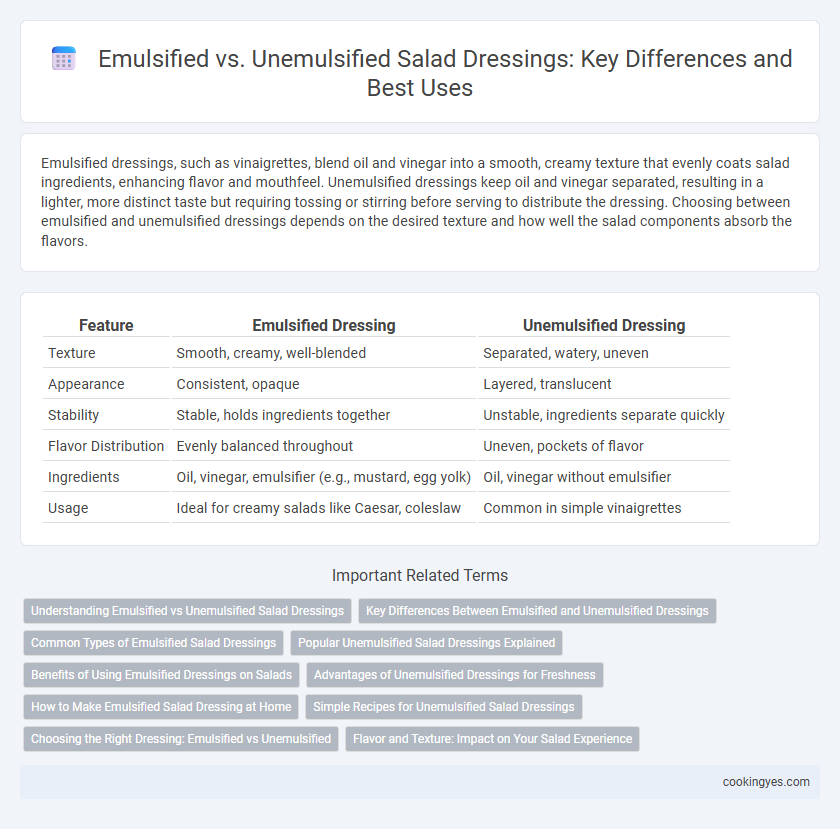Emulsified dressings, such as vinaigrettes, blend oil and vinegar into a smooth, creamy texture that evenly coats salad ingredients, enhancing flavor and mouthfeel. Unemulsified dressings keep oil and vinegar separated, resulting in a lighter, more distinct taste but requiring tossing or stirring before serving to distribute the dressing. Choosing between emulsified and unemulsified dressings depends on the desired texture and how well the salad components absorb the flavors.
Table of Comparison
| Feature | Emulsified Dressing | Unemulsified Dressing |
|---|---|---|
| Texture | Smooth, creamy, well-blended | Separated, watery, uneven |
| Appearance | Consistent, opaque | Layered, translucent |
| Stability | Stable, holds ingredients together | Unstable, ingredients separate quickly |
| Flavor Distribution | Evenly balanced throughout | Uneven, pockets of flavor |
| Ingredients | Oil, vinegar, emulsifier (e.g., mustard, egg yolk) | Oil, vinegar without emulsifier |
| Usage | Ideal for creamy salads like Caesar, coleslaw | Common in simple vinaigrettes |
Understanding Emulsified vs Unemulsified Salad Dressings
Emulsified salad dressings blend oil and water-based ingredients into a stable mixture, creating a creamy texture and consistent flavor, commonly achieved with ingredients like mustard or egg yolk as emulsifiers. Unemulsified dressings, often vinaigrettes, separate naturally because oil and vinegar do not mix, requiring shaking before each use to redistribute the components. Understanding the difference impacts texture, taste, and dressing application, essential for enhancing salad presentation and flavor balance.
Key Differences Between Emulsified and Unemulsified Dressings
Emulsified dressings combine oil and water-based ingredients into a stable, smooth mixture using agents like mustard or egg yolk, resulting in a creamy texture that clings evenly to salad greens. Unemulsified dressings separate into distinct oil and vinegar layers, requiring shaking before use and offering a lighter, more fluid consistency. The key difference lies in texture and stability: emulsified dressings maintain a uniform blend, enhancing flavor distribution, while unemulsified dressings provide a more pronounced oil-and-vinegar taste but need constant mixing to prevent separation.
Common Types of Emulsified Salad Dressings
Common types of emulsified salad dressings include creamy Caesar, classic ranch, and honey mustard, which blend oil and vinegar or lemon juice into a smooth, stable mixture using emulsifiers like egg yolk or mustard. These dressings maintain a uniform texture and rich flavor, enhancing salads without separation. Emulsified dressings contrast with unemulsified varieties, such as simple vinaigrettes, which tend to separate and require shaking before use.
Popular Unemulsified Salad Dressings Explained
Popular unemulsified salad dressings, such as vinaigrettes, consist of oil and vinegar separated into distinct layers that require shaking before use to blend flavors. Common ingredients include extra virgin olive oil, balsamic or red wine vinegar, mustard, and seasonings, creating a tangy and fresh taste profile. These dressings offer a lighter texture compared to emulsified varieties, allowing for customizable acidity and oil ratios to suit individual preferences.
Benefits of Using Emulsified Dressings on Salads
Emulsified dressings blend oil and vinegar into a smooth, stable mixture that evenly coats salad ingredients, enhancing flavor distribution and texture. The uniform consistency of emulsified dressings prevents separation, ensuring each bite is well-balanced with seasoning and moisture. Using emulsified dressings also improves nutrient absorption from vegetables by facilitating the integration of healthy fats.
Advantages of Unemulsified Dressings for Freshness
Unemulsified dressings separate into oil and vinegar layers, preserving each ingredient's distinct flavor and brightness, which enhances the fresh, crisp taste of salads. This separation allows diners to control the amount and distribution of dressing, maintaining the salad's natural texture and preventing sogginess. The lack of emulsifiers also ensures fewer additives, appealing to those seeking a more natural and clean ingredient profile in their salads.
How to Make Emulsified Salad Dressing at Home
To make emulsified salad dressing at home, slowly whisk oil into vinegar or lemon juice while continuously stirring to create a stable mixture where oil droplets are suspended evenly. Using ingredients like mustard or egg yolk can act as natural emulsifiers, enhancing the dressing's texture and preventing separation. For best results, combine the emulsifier with acid first, then slowly drizzle in oil while whisking vigorously until a thick, creamy consistency forms.
Simple Recipes for Unemulsified Salad Dressings
Unemulsified salad dressings consist of separate oil and vinegar layers, making them easy to prepare with just a basic whisk or shake. Simple recipes often combine olive oil, vinegar, salt, and pepper without blending agents, allowing natural flavors to shine through. These dressings are ideal for drizzling over fresh greens, offering a light and customizable taste experience.
Choosing the Right Dressing: Emulsified vs Unemulsified
Choosing the right salad dressing depends on texture and flavor balance, with emulsified dressings offering a creamy, consistent blend of oil and vinegar, ideal for evenly coating greens. Unemulsified dressings separate into oil and vinegar layers, delivering a lighter, tangier experience that allows diners to customize each bite's intensity. Understanding the difference helps enhance salad enjoyment by matching dressing style to desired taste and mouthfeel.
Flavor and Texture: Impact on Your Salad Experience
Emulsified dressings, such as vinaigrettes blended with mustard or egg yolk, create a smooth, creamy texture that evenly coats salad leaves, intensifying flavor distribution. Unemulsified dressings tend to separate, resulting in a lighter, oilier texture and a more segmented taste experience where oil and vinegar flavors are distinct. The choice between emulsified and unemulsified dressings significantly influences the overall mouthfeel and balance of acidity and fat in your salad.
Emulsified vs Unemulsified for dressing Infographic

 cookingyes.com
cookingyes.com